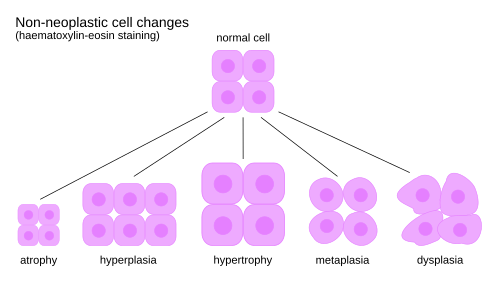Hyperplasia
Hyperplasia is cell proliferation. It leads to enlargement of tissues or organs. It appears (not only) in tissues with greater mitotic activity (glands, skin, mucous membranes).
Physiologically it is present during pregnancy, when uterine hyperplasia occurs. Also, the proliferation of the mammary gland epithelium during puberty due to hormonal stimulation is physiological. When part of the liver is removed, it is regenerated by compensatory hyperplasia. Replication turnover increases up to 10x in hepatocytes.
Pathological hyperplasia of the uterus occurs with excessive production of estrogens. Benign prostatic hyperplasia occurs in men. The cause is an increase in the number of androgen receptors on the surface of the prostate in older age. Pathological hyperplasia is a risk factor for tumor formation.
Hyperplasia along with hypertrophy (increase in cell volume) and hyperregeneration may be among the atypical progressive tissue changes. Examples of hyperplasia are nodular hyperplasia of the adrenal cortex, hyperplasia of the islets of Langerhans, hyperplasia of the gastric mucosa.
- Division:
- Pseudoepitheliomatous – in squamous epithelium with chronic inflammatory irritation of the skin and mucous membranes, after the cause is removed the process heals itself.
- Pseudosarcomatous – it belongs to the so-called fibromatoses, e.g. proliferative fasciitis after trauma.
- Knotty – e.g. in the prostate (in older men with hormonal imbalance) or in the thyroid gland.
- Diffuse – e.g. adrenal glands or parathyroid glands.
Hyper regeneration - e.g. in amputation neuroma(at the site of nerve damage, a pseudo tumor composed of Schwann cells, collagen fibrils and nerve fibers), similar to Morton's neuroma on interdigital plantar nerves, containing additionally thick-walled arterioles with frequent thrombosis, its cause is repeated traumatization.
Source[edit | edit source]
- POVÝŠIL, Ctibor – ŠTEINER, Ivo, et al. Obecná patologie. 1. edition. Praha. 2011. 290 pp. ISBN 978-80-7262-773-8.
- PASTOR, Jan. Langenbeck's medical web page [online]. [cit. 2010]. <https://langenbeck.webs.com/>.

